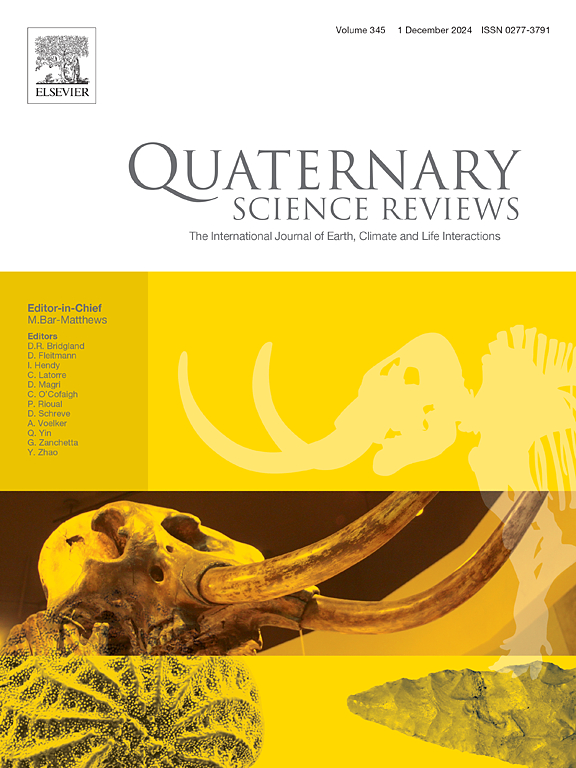Paleoecology and paleoceanography of the Gulf of Corinth revealed by ostracod assemblages
IF 3.2
1区 地球科学
Q1 GEOGRAPHY, PHYSICAL
引用次数: 0
Abstract
The evolution of the Corinth Basin during the last 450,000 years (450 ka) has been investigated using ostracod analyses of two IODP expedition 381 sites M0078 and M0080. M0078 was drilled in the center of the Gulf of Corinth, and M0080 is from the Gulf of Alkyonides. Ostracods were abundant and well preserved in both cores and allowed the correlation of M0078 to M0080 using ostracod assemblages. The ostracods documented brackish lake to marine transitions in both cores during three glacial Terminations (Terminations I, II and V) signifying Marine Isotope Stages (MIS) 2-1, MIS 6-5, and MIS 12-11-10. Radiocarbon dates provided age constraints for the uppermost unit in both cores. For core intervals beyond the range of radiocarbon dating, ages were estimated using the midpoint of depth intervals corresponding to transitions in ostracod assemblages, from brackish Ponto-Caspian to marine-brackish and fully marine biofacies, identified in both cores. These age estimates align well with previous findings from IODP exp. 381, as well as with orbital-scale chronostratigraphic frameworks developed for the Corinth region based on biostratigraphy, tephrochronology, and geophysical data. We interpret the succession of ostracod assemblages during Terminations as evidence for rapid flooding of Corinth and Alkyonides by Mediterranean water during deglacial global sea level rise breaching the shallow (50–60 mwd) Rion and Acheloos sills.
介形类组合揭示的科林斯湾古生态学和古海洋学
利用IODP 381考察地点M0078和M0080的介形类分析,研究了科林斯盆地近45万年(450 ka)的演化。M0078钻井于科林斯湾中部,M0080钻井于炔醇尼德斯湾。两个岩心中介形类丰富且保存完好,利用介形类组合进行了M0078与M0080的对比。介形虫记录了两个岩心在3个冰川终止期(终止期I、II和V)的咸水湖向海洋转变,标志着海洋同位素阶段(MIS) 2-1、MIS 6-5和MIS 12-11-10。放射性碳测年为两个岩心中最上面的单元提供了年龄限制。对于超出放射性碳测年范围的岩心层段,使用与介壳类组合转换相对应的深度层段中点来估计年龄,从半咸水的滨-里海到海洋-半咸水和全海洋生物相,在两个岩心中都有发现。这些年龄估计与IODP exp. 381的先前发现以及基于生物地层学、温度年代学和地球物理数据为科林斯地区开发的轨道尺度年代地层格架非常吻合。我们将Terminations期间介形类组合的演替解释为全球海平面上升期间(50-60 mwd) Rion和Acheloos浅层断裂期间地中海水快速淹没Corinth和Alkyonides的证据。
本文章由计算机程序翻译,如有差异,请以英文原文为准。
求助全文
约1分钟内获得全文
求助全文
来源期刊

Quaternary Science Reviews
地学-地球科学综合
CiteScore
7.50
自引率
15.00%
发文量
388
审稿时长
3 months
期刊介绍:
Quaternary Science Reviews caters for all aspects of Quaternary science, and includes, for example, geology, geomorphology, geography, archaeology, soil science, palaeobotany, palaeontology, palaeoclimatology and the full range of applicable dating methods. The dividing line between what constitutes the review paper and one which contains new original data is not easy to establish, so QSR also publishes papers with new data especially if these perform a review function. All the Quaternary sciences are changing rapidly and subject to re-evaluation as the pace of discovery quickens; thus the diverse but comprehensive role of Quaternary Science Reviews keeps readers abreast of the wider issues relating to new developments in the field.
 求助内容:
求助内容: 应助结果提醒方式:
应助结果提醒方式:


